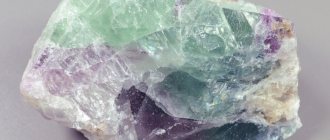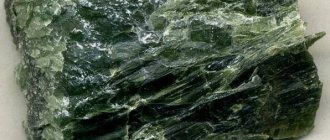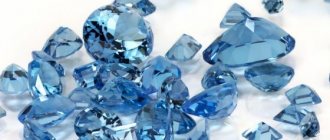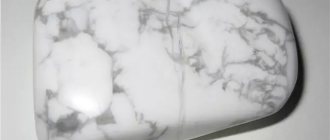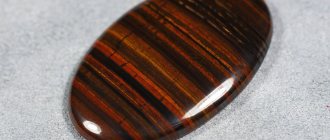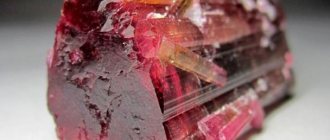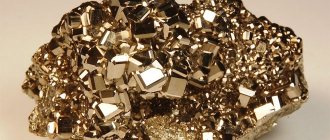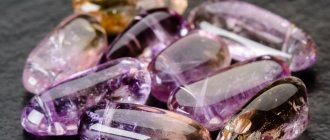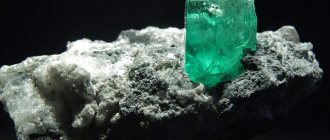Manganite: what is it?
Manganite is a manganese ore mineral.
The stone got its name due to its composition: manganum is translated from Latin as manganese.
It is this component that gives the mineral its main properties: metallic luster and deep gray color.
Manganite is an important industrial mineral.
Properties
In appearance it is similar to pyrolusite, but it can be distinguished due to the imprint that marks leave on the ceramic plates. That is, when a mineral rubs against a plate, a powder is formed. Pyrolusite will have a black streak, while pyrolusite will have a red-brown color. Mineral aggregates are crystalline particles formed from stone fibers that resemble needles. They are called oolites.
| Description | Characteristic |
| Chemical formula | MnO(OH) |
| Hardness | 4 |
| Specific gravity | 4.3 |
| Shine | Metal |
| Typical impurities | Fe,Ba,Pb,Cu,Al,Ca |
| Molecular weight | 87.94 |
| IMA status | valid, first described before 1959 (before IMA) |
| Opening year | 1827 |
| Transparency | Opaque |
| Cleavage | perfect by {010}; on {110} and {001} less perfect. |
| Kink | Uneven |
| Typical impurities | biaxial (+) |
| Refractive indices | nα = 2.250(2) nβ = 2.250(2) nγ = 2.530(2) |
| Maximum birefringence | δ = 0.280 |
| singonia | Monoclinic |
| Pleochroism | Weak |
| Cell Options | a = 8.94Å, b = 5.28Å, c = 5.74Å |
| β = 90° |
Manganite mineral: properties, description and formula
Manganite mineral photo The chemical formula of manganite is MnO(OH).
Up to 90% of the composition is manganese oxide. It may contain silica - SiO2 or iron oxide - Fe2O3 as impurities.
The color of the mineral is black, sometimes gray-black. Opaque crystals are quite fragile and crumble when pressed.
Basic physical properties of manganite:
- hardness - 3.5-4
- density - 4.3-4.4 g/cm3
- shine - metallic
- transparency - opaque
- cleavage - perfect
- syngony - monoclinic
Manganite is one of the most common manganese minerals. It is part of sedimentary manganese ores.
Well-formed crystals form twins and occur in low-temperature hydrothermal veins.
The shape of the crystals is prismatic. The structure is expressed with deep shading on the surface.
Manganite stone. Properties, extraction and use of manganite
It can be confused with pyrolusite, but the imprints dot the i’s. Mineral imprints are the features they leave on ceramic plates. The “signature” of the stone is the powder that separates from it when rubbed against a plate.
Pyrolusite has a black streak. Let's talk about its double - manganite. Fine-crystalline masses of this mineral are similar to pyrolusite in appearance, but leave a red-brown streak.
Description and properties of manganite
Standard manganite aggregates are fine-crystalline, or sinter. The latter are made of stone fibers.
They resemble needles pressed against each other. Fine crystalline aggregates are called oolites.
These are mineral balls, the diameter of which can be calculated in both nanometers and millimeters. The maximum for oolites is 25 millimeters in diameter.
It is the appearance of oolites and needle-like masses of manganite that is close to the appearance of pyrolusite. The chemical formulas of gems are also close.
Pyrolusite is manganese dioxide. Manganite is a metahydroxide of the same metal with the formula MnO (OH).
Both stones are dark, black, or deep gray. But manganite also contains individual, large crystals. This is how a gem is distinguished.
The crystal structure of manganites is reduced to elongated prisms, or columnar aggregates.
Prisms come not only standard, but also with a pyramidal top. Parallel to the elongation of the crystals is shading. It is clearly visible even from a distance.
Occasionally, manganite crystals grow into each other, or are connected by one of the faces.
Such units are called twins. If the crystals are separate, they, as a rule, form druses, that is, they diverge to the sides from one point.
Like pyrolusite, manganite has a metallic luster; there are slightly translucent samples.
But the hero of the article shimmers red, though only on thin chips. In addition, manganese metahydroxide is 2 points harder than its double.
On the Mohs scale, pyrolusite is given only 2, and manganite is given 4. Hardness is tested using a comparative method.
That is, holding two, at first glance, identical stones in your hands, you can pass one over the other. The one that is scratched is softer, which means it is pyrolusite.
Scientists look at all manganites with interest. The structure and properties of manganese oxides began to be closely studied in the 1990s.
The effect of the CMS aroused interest. It stands for “colossal magnetoresistance.”
The effect boils down to a sharp decrease in current resistance if a magnetic field is applied to it. This feature of manganite has a practical application. Let's get to know him.
Application of manganite
used in magnetoresistive memory cells, in highly sensitive sensors, magnetic recording devices and magnetoresistive sensors.
Lantana manganite is especially appropriate in them . Its formula: - LaMnO3. Mineral is the main “player” in the market of a developing branch of innovative electronics called spintronics.
It is based on quantum technologies. The industry studies spin current transfer, that is, the angular momentum of elementary particles in substances with small vibrations of atoms. The latter are called solids.
If we simplify the conversation about the vibrational spectra of manganite , their discovery is a kind of analogue of the discovery of high-temperature superconductors.
The latter came into use in the 1980s. The main superconductors are complex copper oxides. The CMC effect is also supported by oxides.
All of them have active electronic correlation, that is, mutual dependence of the movement of negatively charged particles.
In colossal magnetoresistance, the transition of manganite from the dielectric to the metallic state is important.
For it to occur under normal conditions, you need to raise the temperature to at least 100, or even 200 degrees Celsius.
But, you add a magnetic field and, voila, the transition from one phase to another is complete.
Finally, let's remember the traditional uses of manganite . Along with pyrolusite, it is purchased for ferrous metallurgy as manganese ore.
Ferromanganese is obtained from the mineral. It serves as an alloying component in the smelting of manganese steels.
Manganite is also useful in the manufacture of mirror cast iron. It has a characteristic shiny fracture. Hence the name of the alloy.
Manganite mining
The mineral is sought where hydrothermal processes once actively occurred. The stone is precipitated from solutions, that is, it is of sedimentary origin.
For manganite to form, a deficiency of oxygen is required. Paragenesis, that is, a “genetic” relationship is observed with calcite and barite. It’s worth looking for the hero of the article next to them.
Manganite is rarely found alone. The bulk of the mineral is contained in manganese ores.
Psilomelano-pyrolusite, that is, rich in 4-valent manganese compounds, are located near the coast.
At a distance from them, geologists are looking for carbonate ores. In the latter, manganese is already 2-valent.
You can find manganite in active sources, for example, geysers. The gem is also found in clays.
In them, the mineral forms nodules, that is, convex bodies. The main thing is that they do not come to the surface.
Manganite is not resistant to oxidation. It’s not for nothing that stone formation requires the absence of oxygen.
If it is in excess, manganese is oxidized to the 4-valent state, turning into MnO2.
The richest manganite deposits are located in Germany. Here deposits were discovered in Ilmen, Ilfeld, Tureng and Harz.
All deposits in Germany are hydrothermal and are distinguished by reserves of large crystals, rather than fine-crystalline and sinter masses.
Therefore, collectors order manganite samples, as a rule, from Germany.
For oolitic aggregates you need to go to Georgia. The Chiaturskoye field operates there. It contains brown ore.
Aggregates of similar shape from the Nikolskoye field in Ukraine, black.
In general, manganite is one of the most common manganese minerals. There are small deposits in almost every country.
Application of manganite
Manganite is an important industrial mineral. It acts as a raw material for the production of manganese alloys.
Subsequently, special grades of steel and cast iron are smelted from these alloys.
Well-formed crystals are collectible material. Collectors value them for their unusual appearance.
Perfect cleavage and fragility do not allow the mineral to be used in the jewelry industry.
Origin
The formation of manganite in manganese ores is determined by the presence of rhodochrosite and rhodonite. The crystalline structure of the stone is shaped like elongated prisms. As the crystals elongate, shading is observed, which is visible even from a distance. In rare cases, manganite particles can grow into each other or grow together. In this case, they are called doubles. Otherwise, individual elements form in the form of drusen. It is worth noting the property of the magnet, which is unstable to oxidation. The starting minerals are stibnite and pyrolusite; the stone does not melt.
Characteristic impurities of stones are calcium, iron, aluminum, silicon and barium.
Story
The stone was first described in 1826. The discovery was made by the Australian mineralogist W. Heidinger. This happened in Germany near the town of Ilfeld. Translated from Latin, “manganum” sounds like manganese.
Place of Birth
In most cases, manganite is located at the sites of formation of hydrothermal processes. And it is of sedimentary origin. The mineral is formed with a minimum of oxygen. Most of the minerals are concentrated in manganese ores.
It is also easy to find it in geysers or clays, in the form of nodules or, as they are also called, convex bodies that do not protrude from the surface. Stone deposits are located in Germany in areas of hydrothermal origin in the form of large crystals. Therefore, copies from Germany are often ordered by collectors. In Georgia, due to the deposits of brown ore, specimens from the Chiatura deposit are in demand.
The magical properties of manganite
Manganite optimizes the movement of energies in the sexual chakra Swadiskhana.
That is why the mineral increases the attractiveness of its owner in the eyes of the opposite sex.
This stone also helps overcome stiffness and self-doubt.
Manganite is useful for those who have problems in their personal lives.
Married couples are advised to have a sample of the stone in their home. It will protect against betrayal and cooling of spouses’ feelings.
Practical use
The stone is used in magnetic recording devices and special highly sensitive sensors. It is also used in ferrous metallurgy for the production of ferromanganese, as well as for the smelting of manganese steel.
Jewelers cannot make beautiful jewelry from it, as it is brittle and completely cleavage.
Another area of application is the production of mirror cast iron.
Magic properties
This mineral is great for meditation and activates the movement of energy in the Swadishan chakra. In this way, the owner of the stone becomes attractive to the opposite sex.
- For those who are not doing well in their personal lives, you can carry a stone in your pocket from time to time;
- It is better for married couples to keep it in the house, it will improve the relationship between the two halves and maintain fidelity;
- It is also recommended to be worn by people who are not confident in their own abilities and who are modest.
Influence on Zodiac signs
Astrologers agree that manganite is a universal stone and is suitable for all zodiac signs. The exception is Aquarius, whom he can encourage into defiant behavior. It will help other zodiac signs to increase their ability to speak and find true, loyal friends.
Manganite
MANGANIT
English name: Manganite
Associations: Barite Brownite Gausmanite Calcite Pyrolusite Siderite etc.
Manganite is a mineral, manganese hydroxide, close to the goethite group. The crystal structure differs significantly from the structure of goethite and has not yet been deciphered.
Chemical composition. Manganese oxide (MnO) 40.4%, manganese dioxide (MnO2) 49.4%, water (H2O) 10.2%.
The pearl of borax and phosphorus salt in the oxidizing flame is violet (presence of manganese). In concentrated HCL it dissolves, releasing chlorine.
Origin
It is formed mainly when there is a lack of oxygen. It occurs in the form of drusy crystals in some hydrothermal deposits of manganese as one of the last minerals to be released in paragenesis with barite and calcite. It is found in large masses in sedimentary deposits in the form of oolites and continuous masses, occupying an intermediate position between the facies of psilomelane-pyrolusite ores (compounds of tetravalent manganese) and carbonate ores containing divalent manganese, more distant from the coastline. In clays it is sometimes found in the form of nodules and nodules with a radial structure. Also noted in deposits of hot springs. Unstable in the oxidation zone. It easily turns into cryptocrystalline, almost anhydrous MnO2, i.e. all manganese is oxidized to the tetravalent state. Therefore, manganite is relatively rare in manganese hats.
Place of Birth
Manganite is known in significant quantities in the Chiatura deposit (Georgia) in the form of brown oolitic ores. It is also widely distributed in black spherical nodules in the Nikopol deposit (Ukraine). In the form of crystals, often large, it is known in the Ilfeld hydrothermal deposit in Harz, Ilmenau in Thuringia (Germany) and in other places.
Practical significance.
Along with pyrolusite and psilomelane, Mn ore is important for ferrous metallurgy and the production of ferromanganese; alloying metal for producing manganese steels, mirror cast iron, etc.
The crystals are usually long-columnar to acicular with vertical shading and have few edges. Crystals rich in facets, as a rule, are short-columnar, forming cruciform or cranked twins. Due to incipient weathering, the top faces of the crystals are often porous. Radiant, usually arranged in radial or random fascicles, rarely granular aggregates. Pseudomorphoses of calcite are characteristic. The cleavage is perfect; density 4.3-4.4; color brownish-black, after weathering steel-gray, dash color black.
It is rarely found as a primary mineral, much more often as transformed into pyrolusite. Occurs mainly in low-temperature hydrothermal veins as a product of leaching or accumulation of sediments in shallow seas. The most beautiful crystals in the world come from the Upper Harz (Germany) up to 10 cm long, in porphyry and melaphyre - from Thuringia (Germany), Cornwall (England), Nova Scotia (Canada).
Important manganese ore. Manganese is used for alloying steel, for desulfurization in metallurgical processes, as an oxidizing agent in many chemical processes, for decolorizing glass, for the production of dry elements and many manganese salts.


